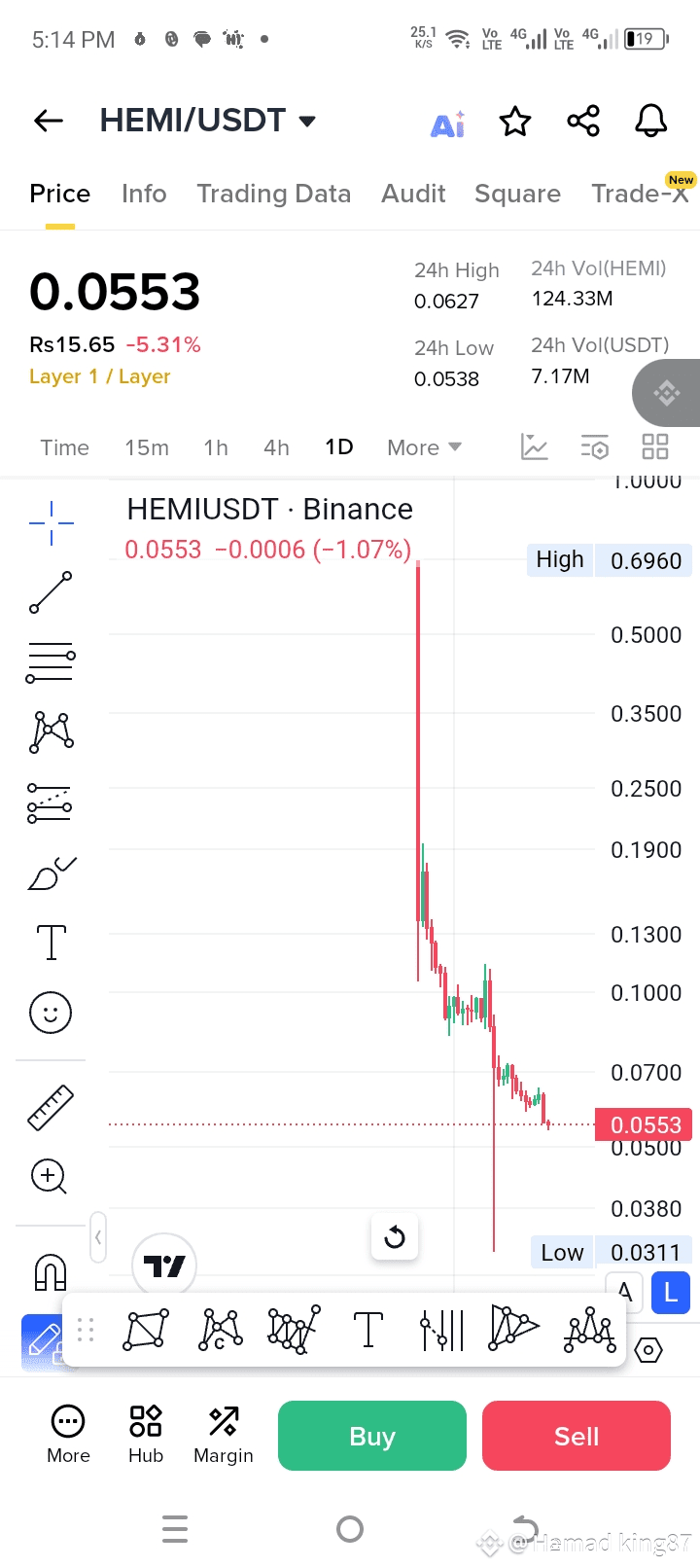Date of Analysis: October 22, 2025
$HEMI Executive Summary: The Dawn of the Bitcoin-Ethereum Supernetwork.The Hemi Protocol and its native token, HEMI, represent one of the most significant architectural advancements in the 2025 blockchain landscape. Moving beyond the limitations of traditional, centralized cross-chain bridges and "wrapped" asset solutions, Hemi is an innovative modular Layer 2 solution that fundamentally reconstructs the relationship between the two largest cryptocurrency ecosystems: Bitcoin and Ethereum.By treating these blockchains not as isolated silos but as complementary components of a single "supernetwork," Hemi aims to unlock Bitcoin's trillions of dollars in dormant value for decentralized finance (DeFi), all while inheriting Bitcoin's robust security model. The HEMI token is the lifeblood of this network, essential for governance, network security via its unique Proof-of-Proof (PoP) consensus, and acting as the future gas token for transaction fees.As of October 22, 2025, Hemi stands at a critical juncture: successfully navigating initial market volatility and focusing on major technical and partnership milestones, including the October 2025 Daemon Refactor and a high-profile strategic partnership with Dominari Holdings aimed at institutional finance integration.
Part I: Decoding the Hemi Protocol Architecture
Hemi is more than a bridge; it is a modular, dual-core Layer 2 protocol built on an architecture designed for superior scaling, security, and interoperability. The project was co-founded by industry heavyweights, including Jeff Garzik (former Bitcoin core developer) and Max Sanchez (inventor of the Proof-of-Proof consensus protocol).
1. The Supernetwork Philosophy
The fundamental vision of Hemi is to solve the decade-old "partition problem" in crypto, where Bitcoin is secure but non-programmable, and Ethereum is programmable but relies on a different security model. Hemi’s “supernetwork” approach fuses these two capabilities into a single, cohesive developer environment.
2. Core Technological Components
Hemi's breakthrough technology hinges on three primary innovations that create a unified operational layer:
A. Hemi Virtual Machine (hVM)
The hVM is the smart contract engine of the Hemi network. It is an enhanced Ethereum Virtual Machine (EVM) with a crucial distinction: it has an embedded Bitcoin node.Functionality: This architecture allows smart contracts deployed on Hemi to natively query and interact with the state and data of the Bitcoin blockchain (e.g., UTXOs, transactions) without relying on third-party, trust-based oracles or wrapped assets.Impact: For the first time, developers can build genuine Bitcoin-native DeFi (BTC-Fi) applications, such as BTC-collateralized lending and derivatives, that directly leverage the security of the underlying Bitcoin chain.
B. Proof-of-Proof (PoP) Consensus
The PoP mechanism is Hemi’s key security innovation, designed to inherit Bitcoin’s "superfinality.Mechanism: PoP miners are incentivized to securely anchor Hemi’s Layer 2 block states onto the Bitcoin blockchain. This process involves creating cryptographic proofs of the Layer 2 state and committing them to the Bitcoin chain.Security & Finality: This anchoring ensures that Hemi’s state transitions inherit the same level of security and censorship resistance as the main Bitcoin chain. It achieves settlement finality within approximately 90 minutes—a robust, decentralized finalization time. PoP miners are rewarded in HEMI tokens for securing the network.Hemi Bitcoin Kit (hBK) and Tunnel. This is a set of developer tools and SDKs that makes the hVM's unique awareness of Bitcoin's state accessible. It empowers dApp builders to create the next generation of BTC-Fi These are the trust-minimized asset transfer mechanisms facilitating movement between Bitcoin, Hemi, and Ethereum. They are designed to offer a more secure and decentralized alternative to traditional, multi-signature bridge systems, significantly reducing counterparty risk.
3. Modularity and Scalabilit
Hemi’s architecture is fundamentally modular, aligning with the current trend in Layer 2 development. This means the core functions (execution, settlement, consensus, data availability) are decoupled.Benefit: This design allows for independent module deployment (as highlighted by the recent Daemon Refactor), lower barriers for node operators, and the ability for developers to launch custom app-chains or rollups that still benefit from Bitcoin's PoP security. This future-proofs the protocol for evolving scaling solutions like decentralized sequencers and zero-knowledge proofs (zk-proofs).
Part II: The HEMI Token Utility and Tokenomic
The HEMI token is the native utility and governance asset of the Hemi supernetwork. Its design is centered on capturing value from network usage and driving decentralization

1. Core Utility Functions
The HEMI token is crucial for the network's function and value accrual:
Protocol Governance: HEMI holders possess the right to submit and vote on proposals concerning the future development, parameters, and protocol upgrades of the Hemi network.
Network Security/Staking: HEMI is used as the incentive and reward mechanism for PoP miners and staked validators. Users lock up HEMI to secure the network and, in return, earn newly minted HEMI tokens and a portion of network fees. This aligns the financial interests of token holders with the network’s operational security.Gas Token: HEMI is intended to serve as the native gas token for transactions on the Hemi Layer 2, ensuring that all network activity directly drives demand and utility for the token.Asset Collateral: As BTC-Fi applications emerge on Hemi, the HEMI token is likely to be utilized as collateral, liquidity provision, or a pair in various decentralized financial instruments and pools.
2. Tokenomics Structure and Supply Dynamics
While precise, real-time distribution figures fluctuate, the core tokenomics structure is a key factor in HEMI's market performance. The total maximum supply is capped at 10.00 Billion HEMI, with a current circulating supply of approximately 977.50 Million HEMI.